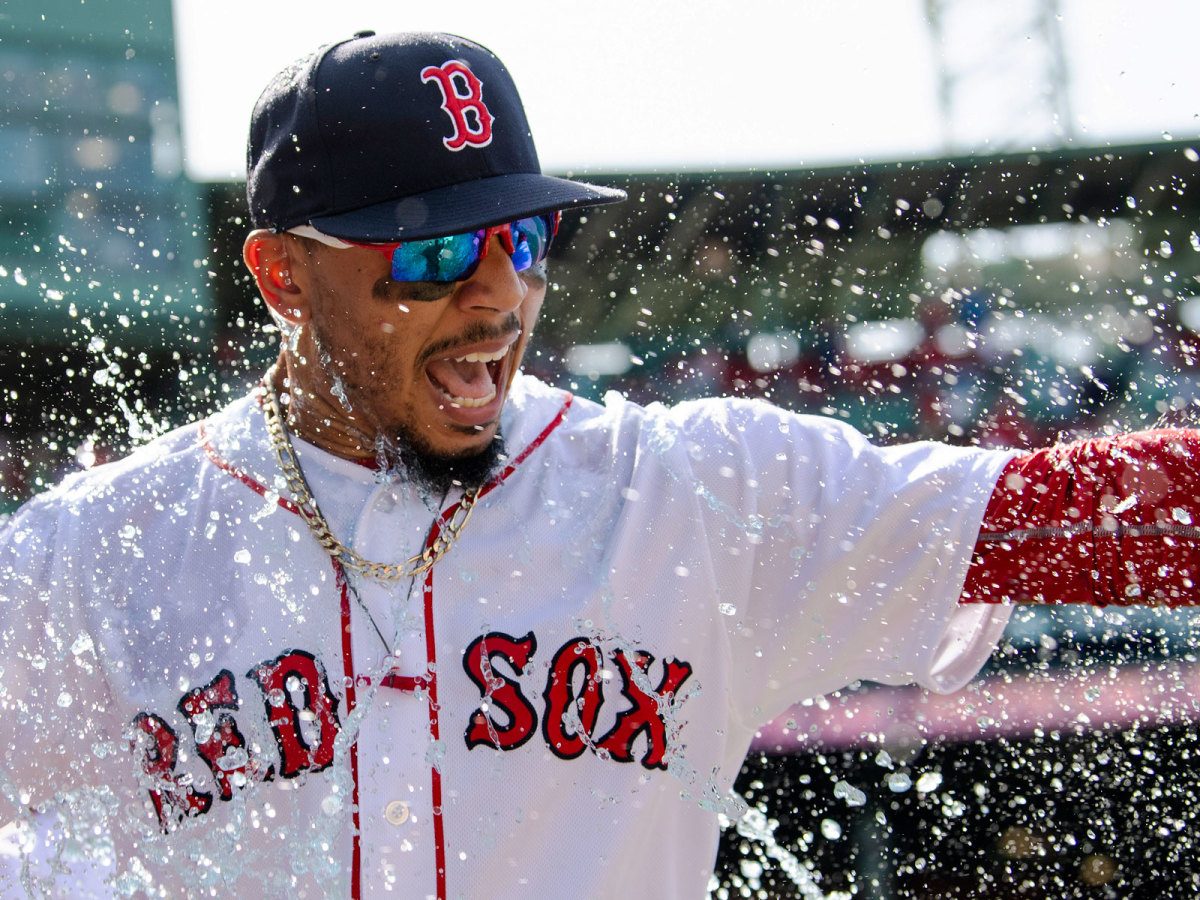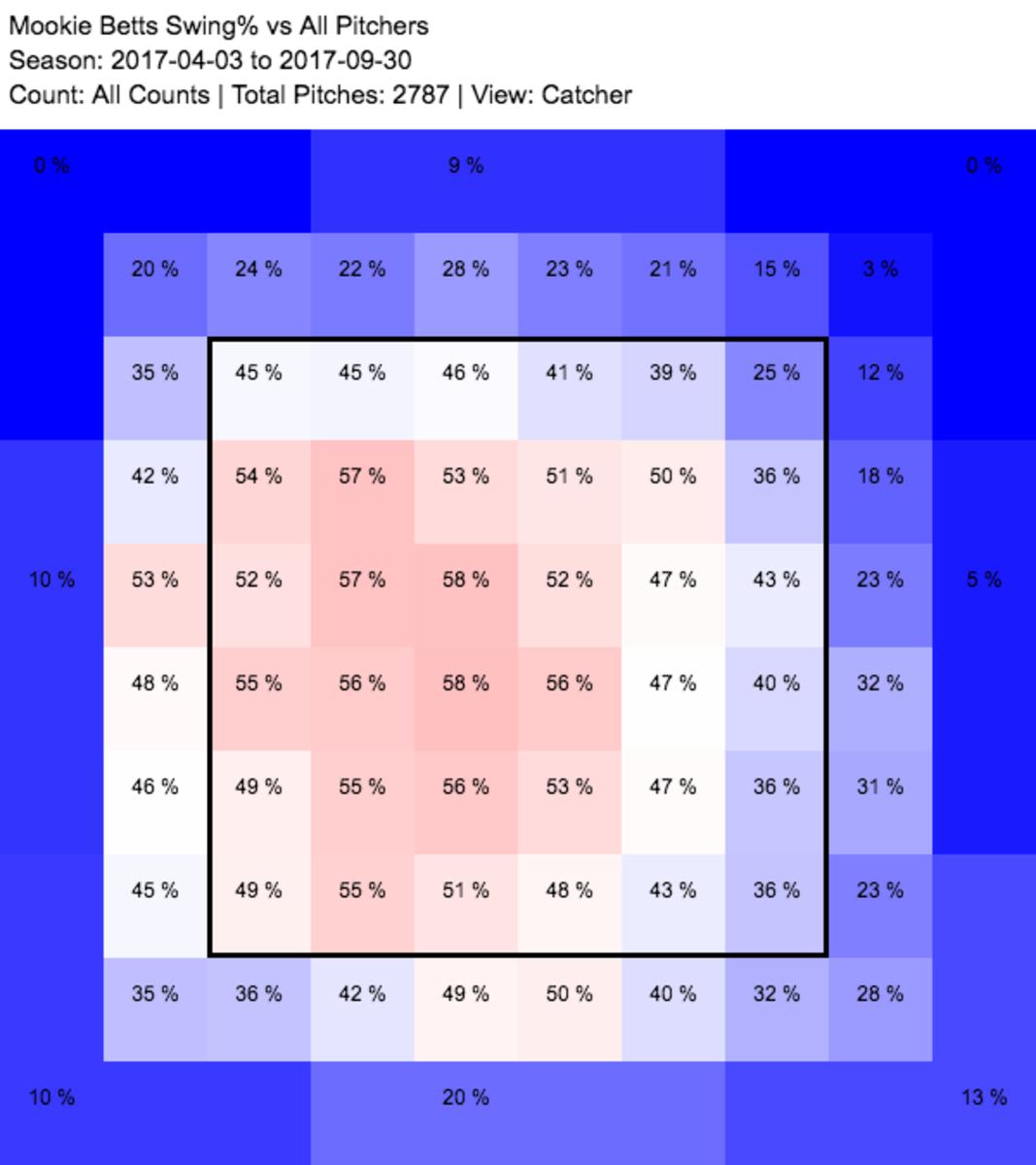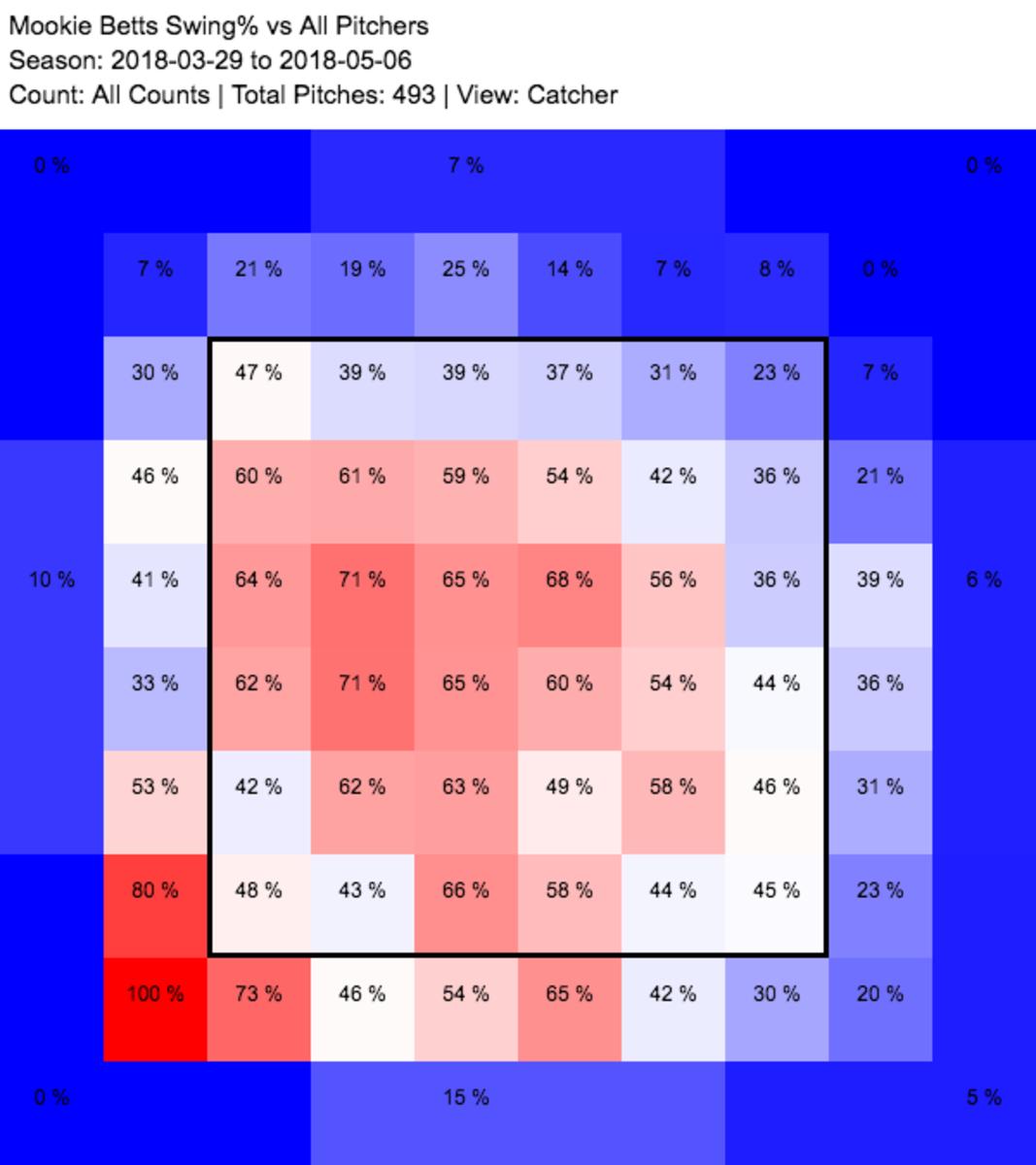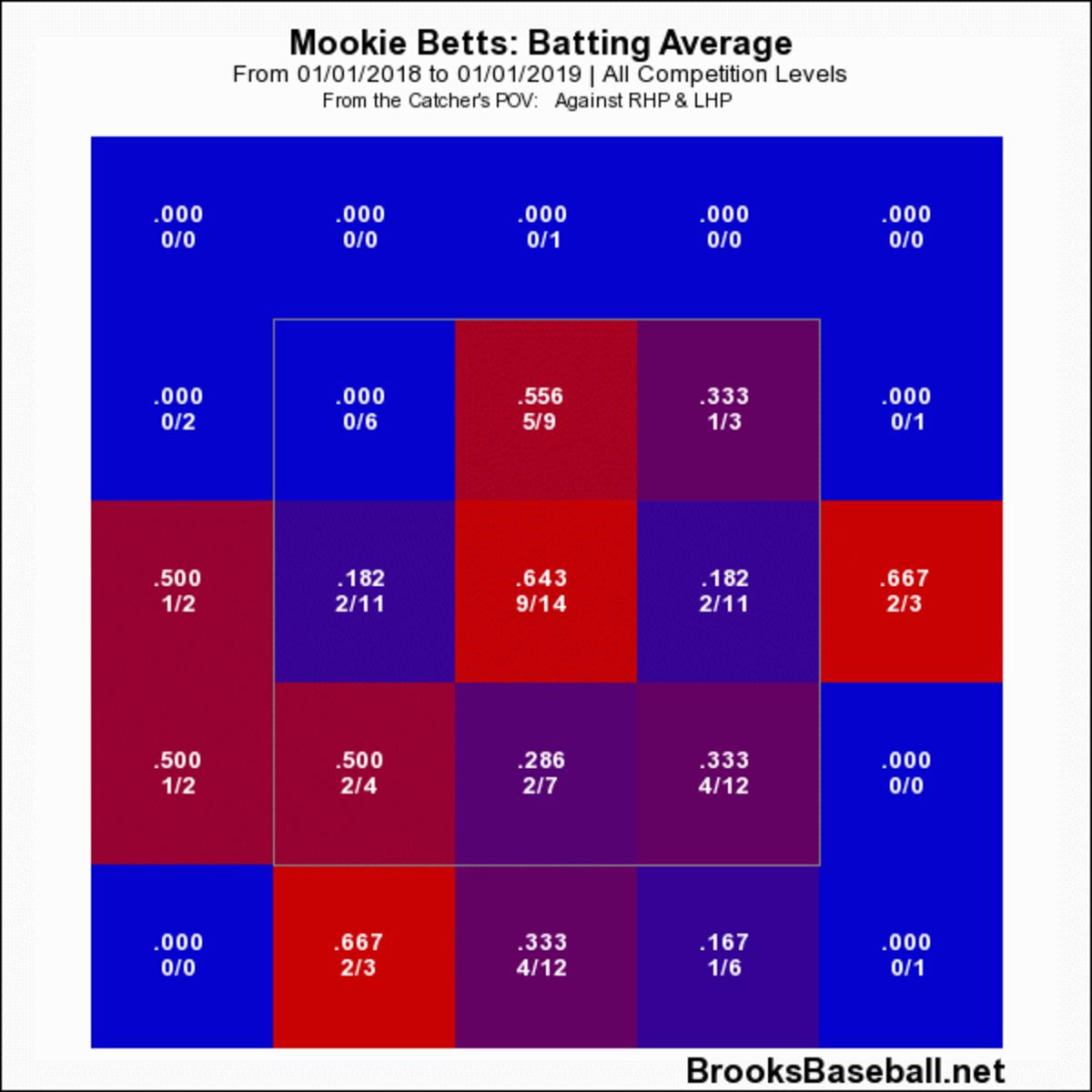Why the Piping Hot Mookie Betts Is One of Baseball's Very Best Players

On Sunday afternoon against the Rangers, Mookie Betts did something unusual: He didn’t homer. That’s mostly because the Red Sox’ star rightfielder didn’t get the chance: He took only two plate appearances against Texas before a bruise on his right shoulder forced him out of the series finale. But while Betts’ week finished on a down note, the overall numbers are plenty high: a .400/.409/1.200 line, five homers and eight RBIs in just six games, including a three-homer outing against the Royals on May 2—already the fourth such game of his career.
That crazy stretch has taken Betts’ already excellent season to another level. After Sunday’s abbreviated action, the 25-year-old is now hitting .355/.434/.818—he leads the league in batting average and slugging percentage—with an MLB-high 13 home runs. He’s also top of the charts in OPS+ (225) and wRC+ (225), and by Baseball-Reference’s Wins Above Replacement, he’s second only to Mike Trout (who else?) with 2.6. Two years after nearly snatching the AL MVP award out of Trout’s hands, Betts is making a serious run at the Angels’ superstar—and at the title of “baseball’s best player”—once more.
Many players have come for Trout’s throne in the last few years, and while some have claimed his hardware—see Jose Altuve winning last year’s AL MVP award thanks in part to Trout missing nearly a third of the year with a thumb injury—few if any can match his tools or production. Betts, though, offers a striking combination of the same things that make Trout great: contact, power, speed and defense. In a breakout 2016 campaign, he put all of those talents together, hitting .318/.363/.534 with 31 homers, 26 steals, a 133 OPS+ and 9.7 WAR, as well as a Gold Glove for his work in right—and all at just 23 years of age. That wasn’t enough to beat Trout for the MVP, as he put together arguably his greatest season yet (.315/.441/.550, 29 HR, 30 SB, 173 OPS+, 10.5 WAR). But it did signal a new and credible challenger to Trout’s perennial status as MLB’s No. 1 player.
But Betts couldn’t back that season up. He slumped across the board in 2017, sinking to a .264/.344/.459 line, a 107 OPS+ and 6.4 WAR. The power and speed numbers remained roughly the same (24 homers and 26 steals), but otherwise, the Mookie of last year bore little resemblance to the one who finished second to Trout in the MVP voting of 2016. (Part of the problem was likely a thumb injury that plagued Betts throughout the second half; his numbers dipped from .272/.351/.490 before the All-Star break to .255/.335/.418 after it.)
Through the first month of this season, though, Betts looks to be back and better than ever. How did he do it? The simple answer is that he’s hitting the ball harder than ever. By FanGraphs’ numbers, Betts’ percentage of hard-hit balls is at 50.5%—fourth-best in the majors among qualified hitters, and a 13-point jump from last year’s mark. Statcast paints a similar picture, with Betts’ percentage of barreled balls jumping from 4.5 last year to a staggering 22.2 this season, which is top three in the game. Betts’ average exit velocity has also spiked, from 88.4 mph in 2017 to 93.2 so far this year. Simply put: When Betts is making contact, he’s hitting it hard.

Unsurprisingly, that jump in hard-hit balls corresponds with a rise in balls put in the air. Betts’ ground-ball-to-fly-ball ratio has been cut nearly in half, from 0.95 last year to 0.57 this year, and he’s slashed his ground-ball rate by over 10 points, from 40.4% to 29.3%. And as his fly-ball rate has gone up (42.8 to 51.5), so too has his home-run-to-fly-ball rate, skyrocketing from 10.1% last season to 25.5% in 2018. His launch angle also suggests a man getting better lift on pitches, as that’s gone from 14.1 degrees in 2017 to 21.4 this year.
That launch angle would suggest that Betts is selling out for fly balls, but a look at his swing suggests nothing of the sort. Aside from dropping a bat waggle in between his setup and his swing, there have been no major or notable changes to his stance. His hot start may have all the hallmarks of the launch angle revolution, but based on the evidence, Betts isn’t praying at that particular altar.
The secret, though, lies not in Betts’ swing but in when he chooses to swing. On the surface, nothing appears to be all that different between his approach last year and this year. His walk and strikeout rates are virtually unchanged, as are the majority of his swing and contact percentages. And one of the hardest men in baseball to get a swing-and-miss from remains so this season, with a swinging-strike rate of 4.3% that ranks fifth lowest in the majors.
There is one stat that stands out, though, and it holds the key to Betts’ brilliant season. That’s his percentage of swings in the strike zone, which has increased five points from last year, 53.8 to 58.8 (and in line with 2016’s 58.4). Last season’s figure was bottom-five in baseball (with teammate Xander Bogaerts dead last at 53%), and while Betts’ 58.8 in 2018 is still low compared to league leaders like teammate J.D. Martinez (83.3) or the free-swinging Javy Baez (82.9), it does represent a fundamental shift in his approach. For that, you can credit new manager Alex Cora, who challenged Betts this offseason to get more aggressive instead of simply taking strikes.
The proof is in the heat maps. The first image is Betts’ swing percentage on all pitches seen in 2017; the second is from this season.


As the bloom of red in the middle and inner half of the plate makes clear, Betts is taking more hacks at pitches in the strike zone—and in particular, he’s swinging more often at pitches in the middle of the plate. Going after belt-high strikes is never a bad strategy, particularly when you have the wrist and bat speed that Betts does, allowing him to turn around high velocity. The results speak for themselves: Check out what Betts is doing to pitches in the middle and top box of the strike zone.

That’s a .609 average on those offerings. Where before Betts was content to let strikes go by, now he’s looking to attack. And when he does get a pitch to hit, he’s unloading on it, pulling the ball (his pull percentage is at 50.5% this year, his highest ever and a nine-point jump from his career mark of 41.4) and putting it into the air for maximum damage.
Now the question becomes how long can Betts keep this up. Pitchers will likely adjust, giving Betts fewer pitches in the zone or trying to get him to chase. But he’s one of the game’s most patient hitters, with an outside-swing percentage of just 20, 11th-lowest in the majors. Whatever happens, though, the Red Sox need him to stay hot. Despite a 17–2 start to the season, Boston has slumped of late, going 8–7 in its last 15 games, and maintains a slim one-game lead in the AL East over the unstoppable Yankees, who have ripped off 15 wins in their last 16 games—and wouldn’t you know it, the two teams start a three-game series at Yankee Stadium on Tuesday. Holding off New York for a third straight division crown will be a team effort, but Betts will likely have to lead the charge.
So long as Mike Trout draws breath, the honor of best player in baseball is his and his alone. Even with Betts’ ludicrous start to the year, he’s still 0.5 WAR behind Trout for first place in that category, and the two-time MVP is putting up his own insane numbers so far this year, hitting .336/.458/.720 with 12 homers, six steals and 28 walks. In this current universe, every other player is fighting to be second best behind him. But this new and somehow improved version of Betts may have a leg up on everyone else in the scrum.
